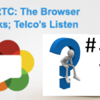
Next Thursday at the WebRTC Conference and Expo, I’ll present a conference keynote that might not be exactly what attendees expect to hear. Most people heading for Atlanta next week understand and embrace WebRTC as a truly disruptive technology; however, we can’t expect this great technology upheaval to happen without serious work behind the scenes.
When many of us think of WebRTC, we think of browser-to-browser voice or video calls. And that capability is important and will be a key use case with WebRTC, but WebRTC is much more than the browser-to-browser call use case.
Remember that there will have to be interactions with non-WebRTC capable endpoints. Yes, imagine that: the world won’t move to WebRTC overnight. There will be facilitators required to connect to the PSTN, other wired and wireless IP endpoints, and mobile endpoints. Facilitators will need to be included that handle both media transcoding and signaling conversion.
In order to really embed WebRTC into the communications fabric, the value-added or vertical service and applications need to be WebRTC-enabled. We could argue that VoIP really took off from the peer-to-peer world into the mainstream once these services became VoIP-enabled. WebRTC has to follow a similar path and embrace these services. And for that, folks, the market will need WebRTC-enabled media servers. The revolution just won’t happen without it.
I’ll talk about this in my keynote on June 27th, and application developers in particular should pay attention. The WebRTC revolution is not a done deal. To get there, we still have a few critical steps to take.













